Real Advantages of Artificial Turf
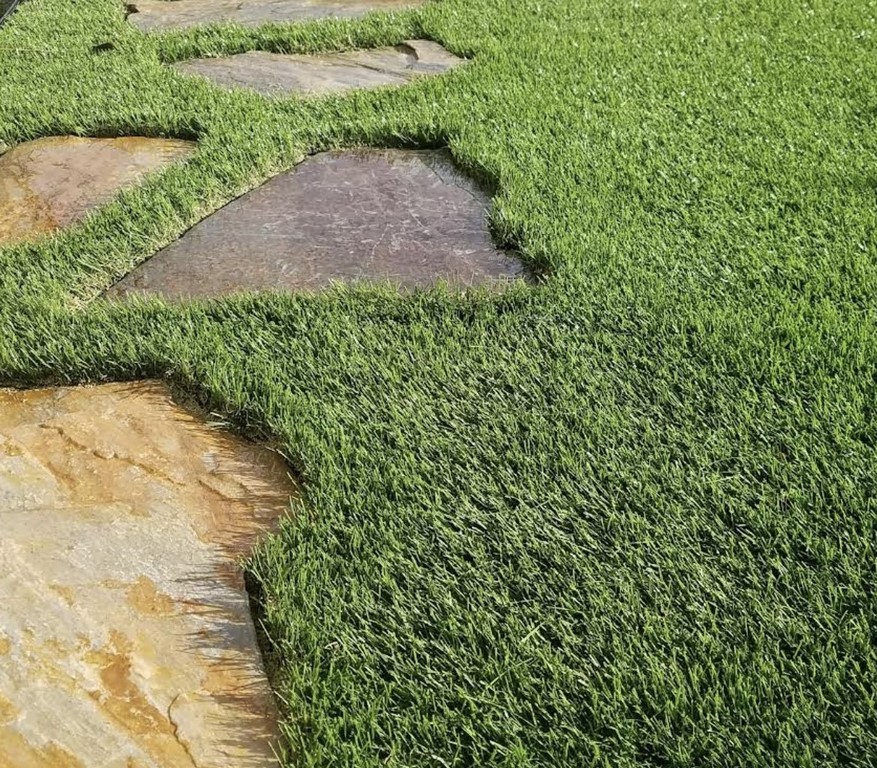

Artificial turf has rapidly grown in popularity in recent years, and especially so in its use beside swimming pools and other bodies of water, says turf specialist Nick Ogilvie. Water conservation, radically reduced maintenance and great appearance are all reasons for the movement toward grass that never grows and never dies.
By Nick Ogilvie
Here in the Sunbelt region, including Texas where we’re located, homeowners and commercial entities often face the challenge of maintaining lush, green landscapes while conserving water.
As H2O becomes more and more expensive, and scarce in times of drought, when watering is sometimes restricted, homeowners have to make tough choices. Sometimes that includes deciding to let a lawn die.
In that context, artificial turf emerges as an innovative solution, especially around pool areas, as we’ll discuss below. Its use not only contributes to a cleaner overall environment but also significantly reduces water usage, a critical consideration in areas prone to drought.
GREEN UPSIDES
It’s really just basic commonsense, in regions where water conservation is a pressing concern due to limited rainfall and high temperatures, artificial turf is a sustainable landscaping choice. Natural grass requires significant amounts of water to stay green and healthy, especially in the Sunbelt region’s harsh summer months. Artificial turn does not.
It needs no watering, saving countless gallons of water annually. When a home owner switches over to artificial turf, they save on average 75% on their water bill. Over time, the savings can offset the initial cost of installing artificial turf, making it a cost-effective solution in the long term.
Indeed, almost every homeowner we encounter is interested in the ROI. When you add up the savings in water, fertilizer, pesticides, mowing and maintenance, artificial turf will pay for itself in four to five years. And, it will always look great.
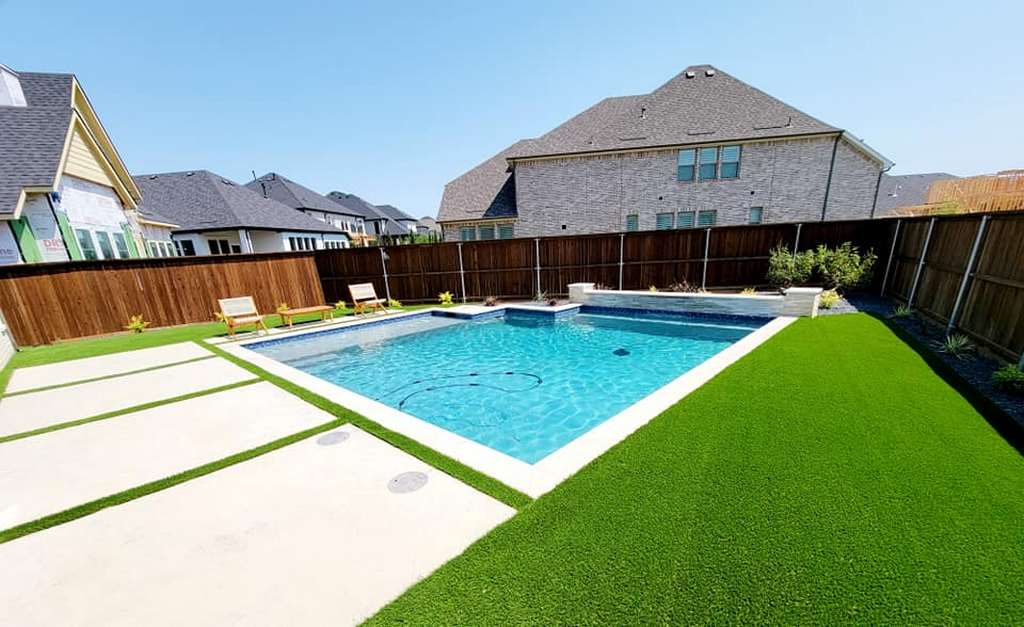
Artificial turf maintains a vibrant, green appearance year-round. It withstands harsh weather conditions, intense sunlight, and heavy foot traffic without fading or wearing down. This durability ensures that the landscape remains visually appealing for years, with minimal maintenance required.
One of the biggest areas of improvement, the appearance of turf products has become far, far more realistic. There was a time when artificial turf looked like green outdoor plastic carpet, which is basically what it was. Today, the shape of the fibers and grass blades have advanced to the point where the appearance and texture rival natural grass.
Artificial turn has also become far more durable. When I started the turf only had an eight-year warranty but now the industry standard is 15 years, largely due to the UV inhibitors that are added during the manufacturing process.
By embracing this innovative solution, homeowners and businesses can enjoy beautiful, low-maintenance pool environments while contributing positively to water conservation efforts.
POOLSIDES PLUSES
The market has grown tremendously over the past 20 years for all of the reasons stated above. In just the last three, we’ve seen a particularly sharp increase in turf installations as part of pool projects. These days, approximately three in five projects we’re doing include swimming pools.
The use of artificial turf around pool areas offers a trifecta of benefits: a cleaner pool environment, significant water conservation, and an enduring aesthetic appeal. One of the primary benefits of using artificial turf around pools is the reduction in debris.
Unlike natural grass, which can shed leaves, blades, and other organic matter, artificial turf remains intact. This means no grass clippings, leaves, and dirt end up in the pool, reducing the need for frequent cleaning and maintenance. Additionally, artificial turf does not require mowing, a common source of debris in pool water. And, there is no fertilizer runoff, which can wreak havoc with pool water chemistry and sanitization.
It’s also great from a safety standpoint. The texture and composition of artificial turf are designed to prevent slipping, making it a smart option for wet poolside areas. The turf’s drainage system allows water to flow through it quickly, reducing puddle formation and minimizing the risk of accidents.
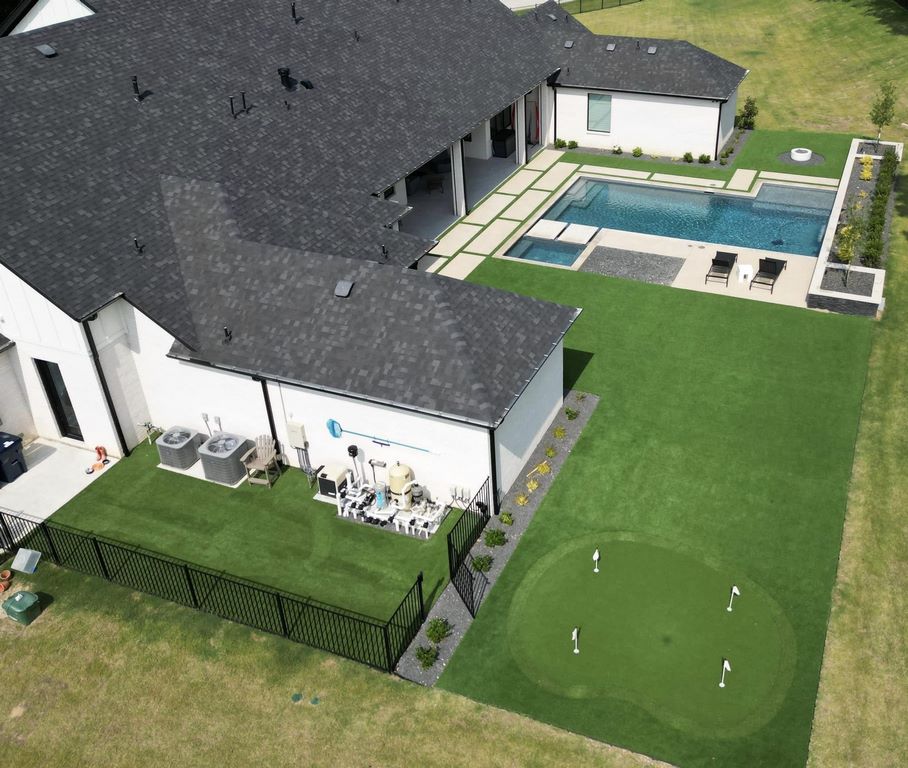
Beyond those reasons, there’s just a natural fit between artificial turf and pools. The cleanliness and comfort of artificial turf is perfect for the area surrounding pools. It’s like the two products feed off each other in the homeowner’s mind.
I must admit that while we enjoy installing turf as part of pool-construction or renovation projects, I’m surprised that more builders don’t take on the task themselves, and earn the profits that go along with it.
As you’re see below, installing artificial turf is not difficult, especially compared to building a swimming pool.
TURF TYPES
There are several types of artificial turf, each with its own characteristics and applications. Here are some common types:
Nylon
Nylon is one of the most durable artificial turf materials, making it suitable for high-traffic areas. It has excellent resilience and can withstand heavy use without losing its shape.
Polyethylene
Polyethylene turf is known for its soft and natural feel, making it popular for residential lawns and landscaping. It often has a more realistic appearance due to its fine texture and color variations.
Polypropylene
Polypropylene is typically less expensive than other materials, making it a budget-friendly option. It may be less resilient than nylon or polyethylene, making it more suitable for less frequently used areas.
Blended Turf
Some artificial turfs are made from a blend of different materials (e.g., a mix of polyethylene and nylon) to capitalize on the strengths of each material. Blended turfs aim to provide a balance between durability, softness, and realism.
Backing Systems
The primary backing is the foundation of the turf, usually made of polypropylene or jute. Some turfs have a secondary backing for added stability and durability, often made of Urethane and latex. (Urethane is the best choice between these two as Latex will start to break down in five years.)
Pile Height and Density
The term “pile height” refers to the length of the artificial grass blades. Shorter pile heights may be more suitable for sports fields, while longer piles are common in residential lawns.
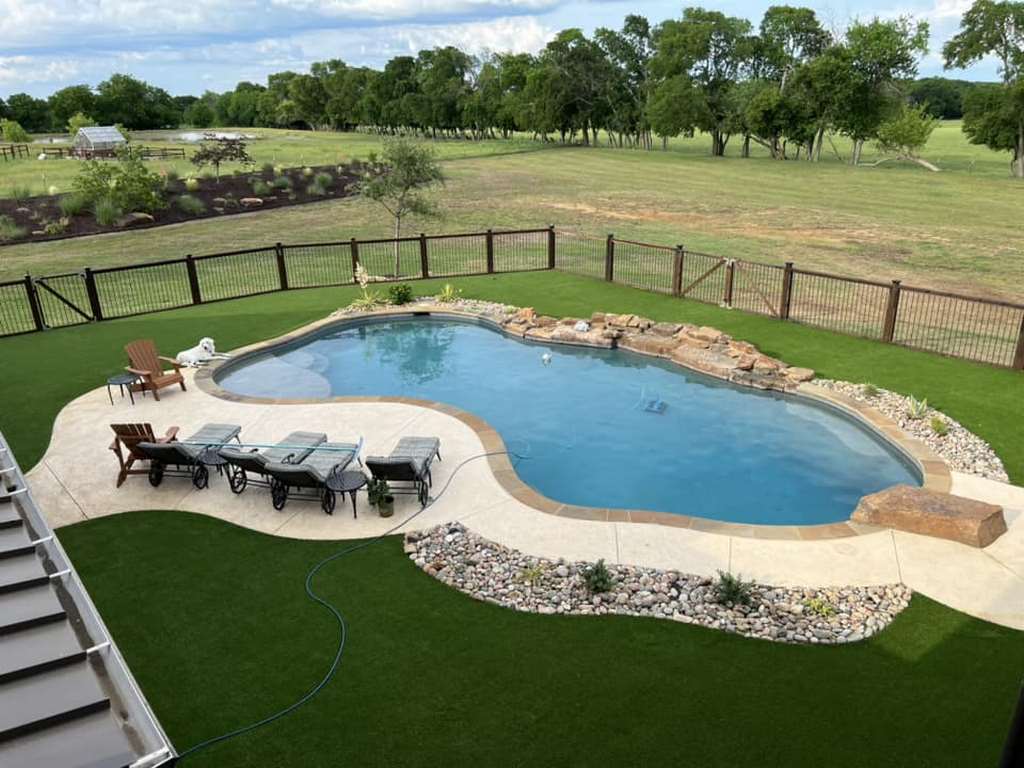
Density is the number of blades per square inch affects the turf’s lushness and appearance.
Infill Types
Rubber Infill: Commonly used for sports fields, rubber infill provides cushioning and helps the turf stand upright.
Coated Sand Infill: These are coated sand infills that are coated with antimicrobial technology that is great for pet and playground areas.
Sand Infill: Sand infill can improve stability and prevent the turf from becoming too hot in direct sunlight.
Organic Infill: Some environmentally-friendly options use materials like cork or coconut fibers instead of traditional infills.
Cooling Technologies
Some advanced artificial turfs incorporate technologies to reduce surface temperatures, making them more comfortable in hot weather.
When choosing artificial turf, it’s essential to consider factors such as intended use, budget, aesthetics, and maintenance requirements to select the most suitable type for a particular application.
PROPER INSTALLATION
Artificial turf installation involves several steps to ensure a proper and long-lasting result. Here is a general overview of the process:
Site Preparation
Remove Existing Grass: If there is natural grass, it needs to be removed. This may involve digging up the existing sod or using a sod cutter to strip away the grass.
Level the Surface: The ground needs to be leveled to ensure a smooth and even surface. Any bumps, rocks, or debris should be removed.
Base Installation
Add Base Material: A base material, typically a combination of crushed stone and topped with fines, is spread over the prepared surface. This base provides stability and drainage for the artificial turf.
Compact the Base: Using a plate compactor, the base material is compacted to at least a 90% compaction rate to create a firm and stable foundation.
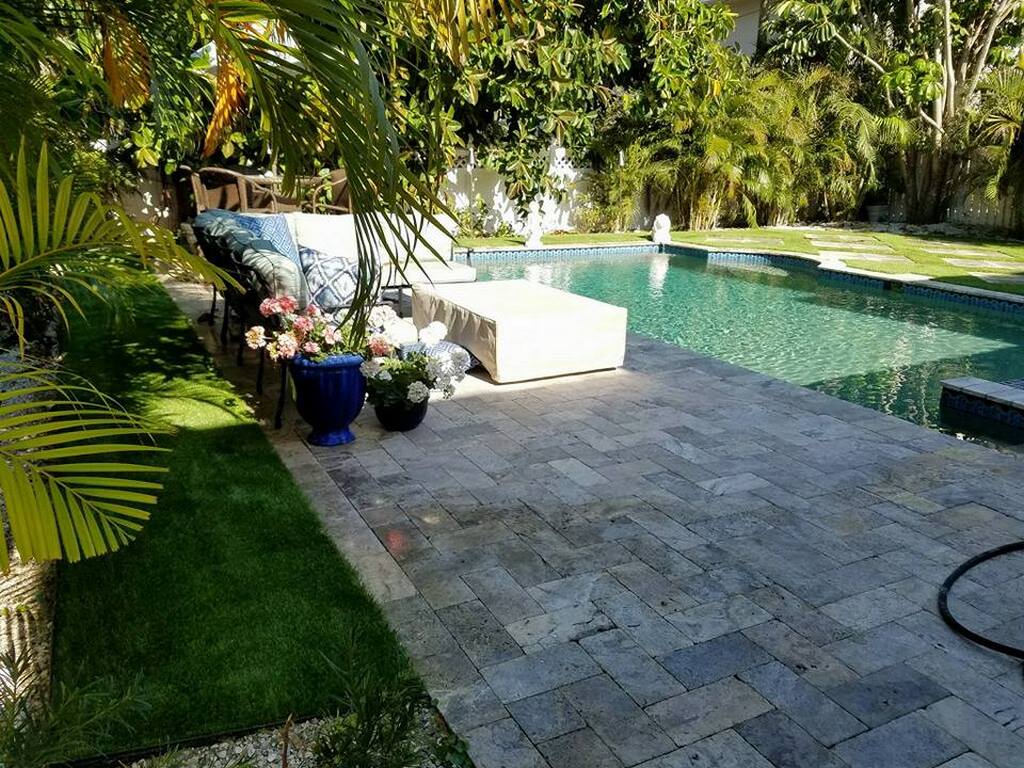
Laying the Artificial Turf
Roll Out the Turf: The artificial turf rolls are laid out over the prepared base. It’s essential to ensure the turf fibers are facing the desired direction. For a backyard you typically want the blades to face towards the house vs the neighbors or fence.
Cut and Trim: Turf pieces may need to be cut and trimmed to fit the specific area. Care is taken to create seamless joints and a natural appearance.
Joining Turf Sections
Seaming: If the area is larger than the width of the turf rolls, the pieces may need to be seamed together. This is typically done using adhesive and special seaming tape.
Secure the Turf
Anchor the Edges: The edges of the turf are secured using landscape staples or other anchoring methods to keep the turf in place.
Adding a Nailer Board
A nailer board is installed around the perimeter of the turf area to provide a secure edge and a clean, finished look. This step is often overlooked in cheaper installations but is crucial for a professional finish and the long-term stability of the turf.
Infill Installation
Spread Infill Material: Infill material, such as sand or rubber granules, is spread over the turf to provide stability, support the blades, and offer a natural feel underfoot.
Brush Infill: A brush or power broom is used to work the infill material into the turf fibers and evenly distribute it.
Brushing and Grooming
Brush Fibers: The artificial turf fibers are brushed or raked to lift them and create a more natural appearance. This also helps the infill settle.
Final Inspection
Check for Issues: Inspect the entire installation for any issues, such as visible seams, uneven surfaces, or other imperfections.
Post-Installation Care
Watering (optional): Depending on the type of infill used, watering the artificial turf may be necessary to help settle the infill and cool the surface.
It’s important to note that specific installation steps may vary based on the type of artificial turf, the location, and the manufacturer’s recommendations. Always refer to the manufacturer’s guidelines for the specific product being installed.
Nick Ogilvie is president of Luxe Blades, an artificial-turf supplier and installation firm based in Celina, TX. A popular author and speaker on the subject, he is widely recognized as a leading expert in the artificial-turf industry. He is author of “Installing and Understanding Artificial Turf: Quick and Easy Guide on How to Successfully Install an Artificial Turf Lawn.” Available here.









